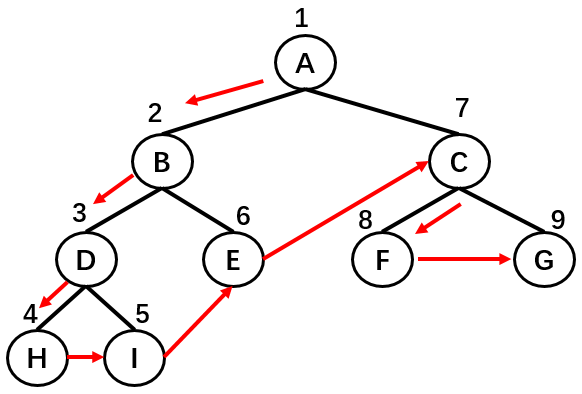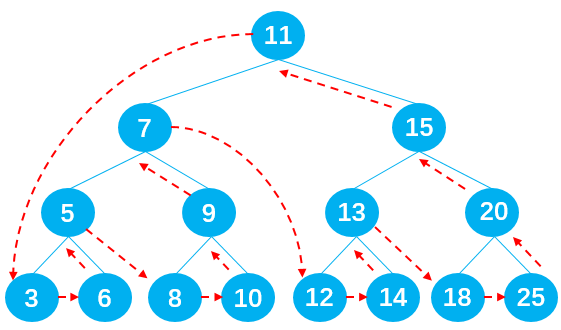二叉搜索树
约 408 字大约 1 分钟
2023-12-27
介绍
又称为 二叉排序树/二叉查询树
是一颗二叉树,可为空
如果不为空,满足以下性质:
- 非空左子树的所有键值小于其根节点的键值
- 非空右子树的所有键值大于其根节点的键值
- 左,右子树本身也都是二叉搜索树
特点
- 小的值在左,大的值在右
TS 实现
可以使用 数组 和 链表 来实现,但是如果使用 数组 的话会造成空间的浪费,所以一般会采用 链表 来实现
namespace 二叉搜索树 {
class BinarySearchTreeNode {
#key: number
#left: BinarySearchTreeNode | null
#right: BinarySearchTreeNode | null
constructor(key: number) {
this.#key = key
this.#left = null
this.#right = null
}
getKey() {
return this.#key
}
setKey(key: number) {
return (this.#key = key)
}
getLeft() {
return this.#left
}
setLeft(left: BinarySearchTreeNode | null) {
return (this.#left = left)
}
getRight() {
return this.#right
}
setRight(right: BinarySearchTreeNode | null) {
return (this.#right = right)
}
}
class BinarySearchTree {
#root: BinarySearchTreeNode | null
insert(key: number) {
const newNode = new BinarySearchTreeNode(key)
if (this.#root === null) {
this.#root = newNode
} else {
this.#insertNode(this.#root, newNode)
}
}
#insertNode(node: BinarySearchTreeNode, newNode: BinarySearchTreeNode) {
if (newNode.getKey() > node.getKey()) {
const right = node.getRight()
if (right === null) {
node.setRight(newNode)
} else {
this.#insertNode(right, newNode)
}
} else {
const left = node.getLeft()
if (left === null) {
node.setLeft(newNode)
} else {
this.#insertNode(left, newNode)
}
}
}
// 先序遍历
preOrderTraversal(handler: (node: BinarySearchTreeNode) => any) {
this.#preOrderTraversalNode(this.#root, handler)
}
#preOrderTraversalNode(node: BinarySearchTreeNode | null, handler: (node: BinarySearchTreeNode) => any) {
if (node === null) return
handler(node)
this.#preOrderTraversalNode(node.getLeft(), handler)
this.#preOrderTraversalNode(node.getRight(), handler)
}
// 中序遍历
inOrderTraversal(handler: (node: BinarySearchTreeNode) => any) {
this.#inOrderTraversalNode(this.#root, handler)
}
#inOrderTraversalNode(node: BinarySearchTreeNode | null, handler: (node: BinarySearchTreeNode) => any) {
if (node === null) return
this.#inOrderTraversalNode(node.getLeft(), handler)
handler(node)
this.#inOrderTraversalNode(node.getRight(), handler)
}
// 后序遍历
postOrderTraversal(handler: (node: BinarySearchTreeNode) => any) {
this.#postOrderTraversalNode(this.#root, handler)
}
#postOrderTraversalNode(node: BinarySearchTreeNode | null, handler: (node: BinarySearchTreeNode) => any) {
if (node === null) return
this.#postOrderTraversalNode(node.getLeft(), handler)
this.#postOrderTraversalNode(node.getRight(), handler)
handler(node)
}
min() {
let node = this.#root
if (node === null) return node
let left = node.getLeft()
while (left !== null) {
node = left
left = node.getLeft()
}
return node.getKey()
}
max() {
let node = this.#root
if (node === null) return node
let right = node.getRight()
while (right !== null) {
node = right
right = node.getRight()
}
return node.getKey()
}
search(key: number) {
return this.#searchNode(this.#root, key)
}
#searchNode(node: BinarySearchTreeNode | null, key: number) {
if (node === null) return false
if (key < node.getKey()) {
return this.#searchNode(node.getLeft(), key)
} else if (key > node.getKey()) {
return this.#searchNode(node.getRight(), key)
} else {
return node
}
}
search2(key: number) {
let node = this.#root
let nowKey: number | null = null
while (node !== null) {
nowKey = node.getKey()
if (key < nowKey) {
node = node.getLeft()
} else if (key > nowKey) {
node = node.getRight()
} else {
return node
}
}
return false
}
remove(key: number) {
if (this.#root === null) return this.#root
let current: BinarySearchTreeNode | null = this.#root
const rootKey = this.#root.getKey()
let parent: BinarySearchTreeNode | null = null
let isLeftChild = true
let currentKey = current.getKey()
while (currentKey !== key) {
parent = current
if (key < currentKey) {
isLeftChild = true
current = current.getLeft()
} else {
isLeftChild = false
current = current.getRight()
}
if (current === null) return false
}
if (current.getLeft() === null && current.getRight() === null) {
// 如果没有子节点
if (currentKey === rootKey) {
this.#root = null
} else if (isLeftChild) {
if (parent === null) return parent
parent.setLeft(null)
} else {
if (parent === null) return parent
parent.setRight(null)
}
} else if (current.getLeft() === null) {
// 如果没有左子节点
if (current.getKey() === rootKey) {
this.#root = current.getRight()
} else if (isLeftChild) {
if (parent === null) return parent
parent.setLeft(current.getRight())
} else {
if (parent === null) return parent
parent.setRight(current.getRight())
}
} else if (current.getRight() === null) {
// 如果没有右子节点
if (current.getKey() === rootKey) {
this.#root = current.getLeft()
} else if (isLeftChild) {
if (parent === null) return parent
parent.setLeft(current.getLeft())
} else {
if (parent === null) return parent
parent.setRight(current.getLeft())
}
} else {
// 如果有右还有右子节点
let successor = this.getSuccessor(current)
if (currentKey === rootKey) {
this.#root = successor
} else if (isLeftChild) {
if (parent === null) return parent
parent.setLeft(successor)
} else {
if (parent === null) return parent
parent.setRight(successor)
}
if (successor === null) return successor
successor.setLeft(current.getLeft())
}
return true
}
getSuccessor(delNode: BinarySearchTreeNode) {
let successorParent: BinarySearchTreeNode | null = delNode
let successor = delNode.getRight()
let current = delNode.getRight()
while (current !== null) {
successorParent = successor
successor = current
current = current.getLeft()
}
if (successor !== delNode.getRight()) {
if (successorParent === null || successor === null) return successor
successorParent.setLeft(successor.getRight())
successor.setRight(delNode.getRight())
}
return successor
}
}
}实现原理
遍历数据
这里所说的树的遍历不仅仅针对二叉搜索树,而是适用于所有的二叉树.
常见的三种二叉树遍历方式为:
- 先序遍历
- 中序遍历
- 后序遍历
先序遍历
首先,遍历根节点,然后,遍历其左子树,最后,遍历其右子树

如上图所示,二叉树的节点遍历顺序为: A -> B -> D -> H -> I -> E -> C -> F -> G
中序遍历
首先,遍历其左子树,然后,遍历根 ( 父 ) 节点,最后,遍历其右子树

输出节点的顺序应为: 3 -> 5 -> 6 -> 7 -> 8 -> 9 -> 10 -> 11 -> 12 -> 13 -> 14 -> 15 -> 18 -> 20 -> 25
后序遍历
首先,遍历其左子树,然后,遍历其右子树,最后,遍历根 ( 父 ) 节点

输出节点的顺序应为: 3 -> 6 -> 5 -> 8 -> 10 -> 9 -> 7 -> 12 -> 14 -> 13 -> 18 -> 25 -> 20 -> 15 -> 11
